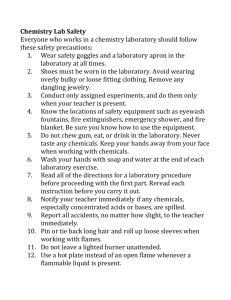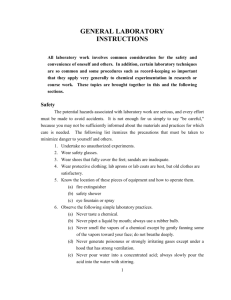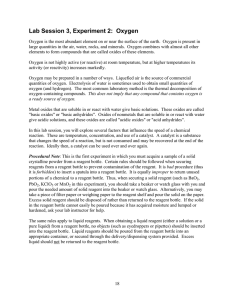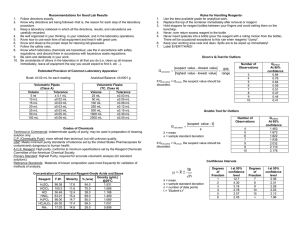Lab Session 3, Experiment 2: Oxygen
advertisement
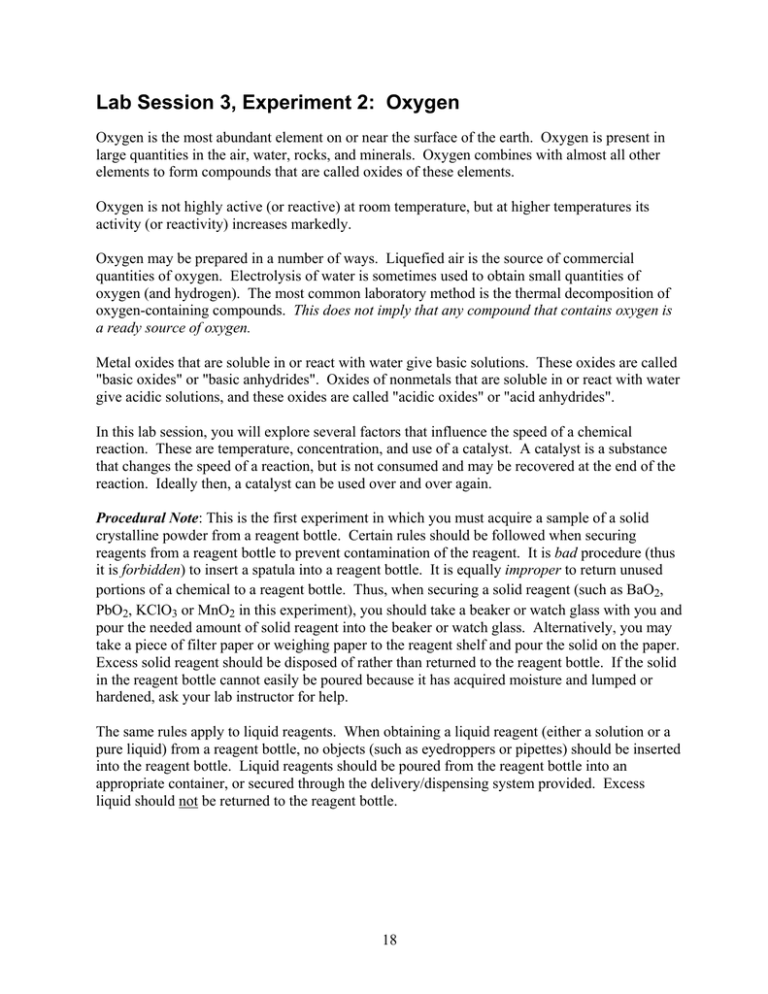
Lab Session 3, Experiment 2: Oxygen Oxygen is the most abundant element on or near the surface of the earth. Oxygen is present in large quantities in the air, water, rocks, and minerals. Oxygen combines with almost all other elements to form compounds that are called oxides of these elements. Oxygen is not highly active (or reactive) at room temperature, but at higher temperatures its activity (or reactivity) increases markedly. Oxygen may be prepared in a number of ways. Liquefied air is the source of commercial quantities of oxygen. Electrolysis of water is sometimes used to obtain small quantities of oxygen (and hydrogen). The most common laboratory method is the thermal decomposition of oxygen-containing compounds. This does not imply that any compound that contains oxygen is a ready source of oxygen. Metal oxides that are soluble in or react with water give basic solutions. These oxides are called "basic oxides" or "basic anhydrides". Oxides of nonmetals that are soluble in or react with water give acidic solutions, and these oxides are called "acidic oxides" or "acid anhydrides". In this lab session, you will explore several factors that influence the speed of a chemical reaction. These are temperature, concentration, and use of a catalyst. A catalyst is a substance that changes the speed of a reaction, but is not consumed and may be recovered at the end of the reaction. Ideally then, a catalyst can be used over and over again. Procedural Note: This is the first experiment in which you must acquire a sample of a solid crystalline powder from a reagent bottle. Certain rules should be followed when securing reagents from a reagent bottle to prevent contamination of the reagent. It is bad procedure (thus it is forbidden) to insert a spatula into a reagent bottle. It is equally improper to return unused portions of a chemical to a reagent bottle. Thus, when securing a solid reagent (such as BaO2, PbO2, KClO3 or MnO2 in this experiment), you should take a beaker or watch glass with you and pour the needed amount of solid reagent into the beaker or watch glass. Alternatively, you may take a piece of filter paper or weighing paper to the reagent shelf and pour the solid on the paper. Excess solid reagent should be disposed of rather than returned to the reagent bottle. If the solid in the reagent bottle cannot easily be poured because it has acquired moisture and lumped or hardened, ask your lab instructor for help. The same rules apply to liquid reagents. When obtaining a liquid reagent (either a solution or a pure liquid) from a reagent bottle, no objects (such as eyedroppers or pipettes) should be inserted into the reagent bottle. Liquid reagents should be poured from the reagent bottle into an appropriate container, or secured through the delivery/dispensing system provided. Excess liquid should not be returned to the reagent bottle. 18 2A Experiment 1. Clean and dry your large test tube. Add KClO3 to the test tube to a height of 2 - 3 cm; add, using a spatula, a pinch of catalyst, MnO2. Mix well. Mount the test tube to a ring stand as shown in Figure 3.1. Check to make sure that the glass tube through the rubber stopper fits tightly, that the rubber stopper fits tightly in the test tube, and that the rubber tube for delivery to the pneumatic trough fits tightly on the glass tube through the rubber stopper. The rubber tubes may need to be secured by a hose clamp or by wire windings. Tight fits prevent oxygen loss to the atmosphere. 2. Prepare to collect oxygen by displacement of water. You will need two 8 oz bottles of oxygen, so before initiating the decomposition of KClO3, fill, invert, and position in the pneumatic trough both bottles. Heat the test tube, gently at first, to start the decomposition. After each bottle is filled, cover the mouth of the bottle with a watch glass, remove it from the trough, and set it right side up on the desk. Figure 3.1 2 KClO3 (sol) ⎯Catalyst ⎯⎯→ 2 KCl(sol) + 3 O2 (gas) (a) What does the collection of oxygen by displacement of water indicate about the solubility of O2 in water? (b) List four physical properties of oxygen. (c) What is the purpose of MnO2? 19 3. Add about 10 mL of water to each of the oxygen-filled bottles. Move the watch glass aside slightly and lower a glowing splint into the bottle. Allow the combustion to continue for several seconds. Remove the splint, cover the bottle, and swirl to mix the water and gas. (d) What gas was produced by the combustion? (e) Write the equation for the reaction between the gas produced and the water. (f) Test the solution formed with litmus paper. What do you observe? (g) Classify the oxide formed by the combustion as acidic or basic: 4. Under the hood, place a small amount of sulfur in a combustion spoon. Ignite the sulfur with the burner flame. Lower the burning sulfur into the second oxygen bottle. (h) Record your observations. (i) What gas is produced by the combustion? (j) Write the equation for the reaction between the gas and water. (k) Test the solution in the bottle with litmus paper. What do you observe? (l) Classify the oxide formed by the combustion of sulfur as acidic or basic: 20 Name__________________________________ Partner____________________Section #_____ Report Form 2: Oxygen (a) Is O2 soluble or insoluble in water? (b) List four physical properties of oxygen. (c) What is the purpose of MnO2? (d) What gas was produced by the combustion? (e) Write the equation for the reaction between the gas produced and the water. (f) Test the solution formed with litmus paper. What do you observe? (g) Classify the oxide formed by the combustion as acidic or basic: (h) Record your observations. (i) What gas is produced by the combustion? (j) Write the equation for the reaction between the gas and water. (k) Test the solution in the bottle with litmus paper. What do you observe? (l) Classify the oxide formed by the combustion of sulfur as acidic or basic: 21
